将搜索添加到 ASP.NET Core MVC 应用
在本部分中,将向 Index 操作方法添加搜索功能,以实现按“类型”或“名称”搜索电影。
使用以下代码更新 Index 方法:
C#
public async Task<IActionResult> Index(string searchString)
{
var movies = from m in _context.Movie
select m;
if (!String.IsNullOrEmpty(searchString))
{
movies = movies.Where(s => s.Title.Contains(searchString));
}
return View(await movies.ToListAsync());
}
Index 操作方法的第一行创建了 LINQ 查询用于选择电影:
C#
var movies = from m in _context.Movie
select m;
此时仅对查询进行了定义,它还不会针对数据库运行。
如果 searchString 参数包含一个字符串,电影查询则会被修改为根据搜索字符串的值进行筛选:
C#
if (!String.IsNullOrEmpty(searchString))
{
movies = movies.Where(s => s.Title.Contains(searchString));
}
上面的 s => s.Title.Contains() 代码是 Lambda 表达式。 Lambda 在基于方法的 LINQ 查询中用作标准查询运算符方法的参数,如 Where 方法或 Contains(上述的代码中所使用的)。 在对 LINQ 查询进行定义或通过调用方法(如 Where、Contains 或 OrderBy)进行修改后,此查询不会被执行。 相反,会延迟执行查询。 这意味着表达式的计算会延迟,直到真正循环访问其实现的值或者调用 ToListAsync 方法为止。 有关延迟执行查询的详细信息,请参阅Query Execution(查询执行)。
注意:Contains 方法在数据库上运行,而不是在上面显示的 C# 代码中运行。 查询是否区分大小写取决于数据库和排序规则。 在 SQL Server 上,Contains 映射到 SQL LIKE,这是不区分大小写的。 在 SQLite 中,由于使用了默认排序规则,因此需要区分大小写。
导航到 /Movies/Index。 将查询字符串(如 ?searchString=Ghost)追加到 URL。 筛选的电影将显示出来。
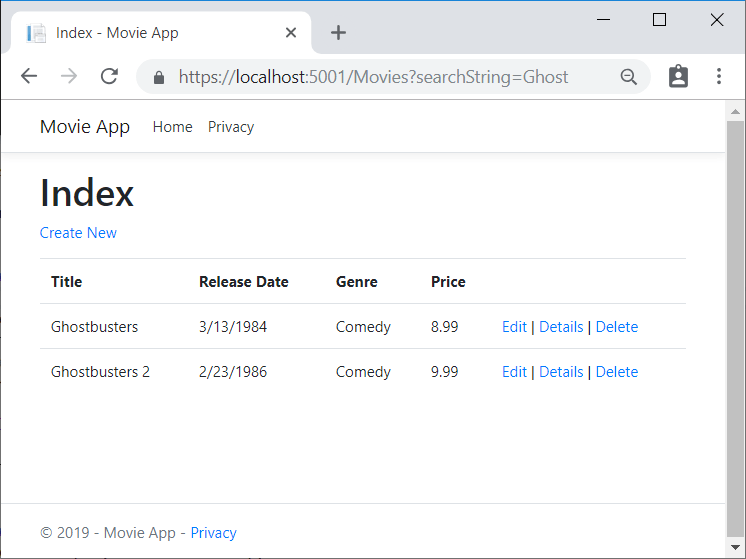
如果将 Index 方法的签名更改为具有名称为 id 的参数,则 id 参数将匹配 Startup.cs 中设置的默认路由的可选 {id} 占位符。
C#
app.UseMvc(routes =>
{
routes.MapRoute(
name: "default",
template: "{controller=Home}/{action=Index}/{id?}");
});
将参数更改为 id,并将出现的所有 searchString 更改为 id。
之前的 Index 方法:
C#
public async Task<IActionResult> Index(string searchString)
{
var movies = from m in _context.Movie
select m;
if (!String.IsNullOrEmpty(searchString))
{
movies = movies.Where(s => s.Title.Contains(searchString));
}
return View(await movies.ToListAsync());
}
更新后带 id 参数的 Index 方法:
C#
public async Task<IActionResult> Index(string id)
{
var movies = from m in _context.Movie
select m;
if (!String.IsNullOrEmpty(id))
{
movies = movies.Where(s => s.Title.Contains(id));
}
return View(await movies.ToListAsync());
}
现可将搜索标题作为路由数据( URL 段)而非查询字符串值进行传递。
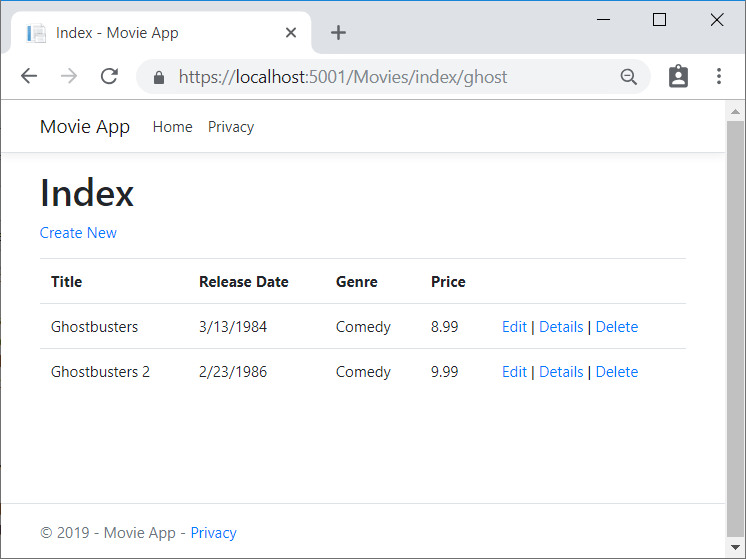
但是,不能指望用户在每次要搜索电影时都修改 URL。 因此需要添加 UI 元素来帮助他们筛选电影。若已更改 Index 方法的签名,以测试如何传递绑定路由的 ID 参数,请改回原样,使其采用名为 searchString 的参数:
C#
public async Task<IActionResult> Index(string searchString)
{
var movies = from m in _context.Movie
select m;
if (!String.IsNullOrEmpty(searchString))
{
movies = movies.Where(s => s.Title.Contains(searchString));
}
return View(await movies.ToListAsync());
}
打开“Views/Movies/Index.cshtml”文件,并添加以下突出显示的 <form> 标记:
HTML
ViewData["Title"] = "Index";
}
<h2>Index</h2>
<p>
<a asp-action="Create">Create New</a>
</p>
<form asp-controller="Movies" asp-action="Index">
<p>
Title: <input type="text" name="SearchString">
<input type="submit" value="Filter" />
</p>
</form>
<table class="table">
<thead>
此 HTML <form> 标记使用表单标记帮助程序,因此提交表单时,筛选器字符串会发布到电影控制器的 Index 操作。 保存更改,然后测试筛选器。
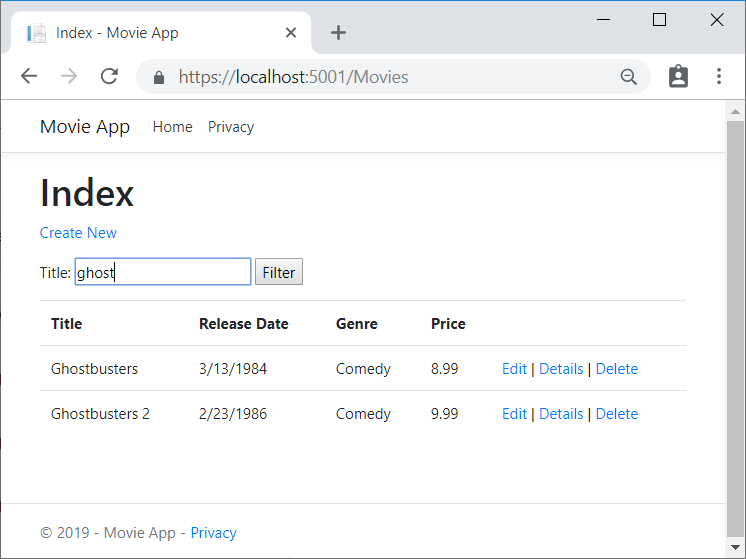
如你所料,不存在 Index 方法的 [HttpPost] 重载。 无需重载,因为该方法不更改应用的状态,仅筛选数据。
可添加以下 [HttpPost] Index 方法。
C#
[HttpPost]
public string Index(string searchString, bool notUsed)
{
return "From [HttpPost]Index: filter on " + searchString;
}
notUsed 参数用于创建 Index 方法的重载。 本教程稍后将对此进行探讨。
如果添加此方法,则操作调用程序将与 [HttpPost] Index 方法匹配,且将运行 [HttpPost] Index 方法,如下图所示。
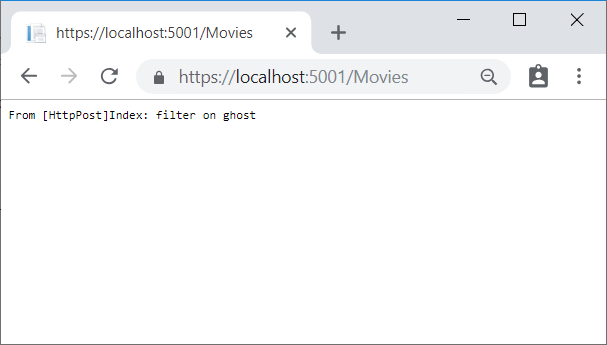
但是,即使添加 Index 方法的 [HttpPost] 版本,其实现方式也受到限制。 假设你想要将特定搜索加入书签,或向朋友发送一个链接,让他们单击链接即可查看筛选出的相同电影列表。 请注意,HTTP POST 请求的 URL 与 GET 请求的 URL 相同 (localhost:xxxxx/Movies/Index),其中不包含搜索信息。 搜索字符串信息作为表单域值发送给服务器。 可使用浏览器开发人员工具或出色的 Fiddler 工具对其进行验证。 下图展示了 Chrome 浏览器开发人员工具:

在请求正文中,可看到搜索参数和 XSRF 标记。 请注意,正如之前教程所述,表单标记帮助程序 会生成一个 XSRF 防伪标记。 不会修改数据,因此无需验证控制器方法中的标记。
搜索参数位于请求正文而非 URL 中,因此无法捕获该搜索信息进行书签设定或与他人共享。 将通过指定请求为 HTTP GET 进行修复:
HTML
@model IEnumerable<MvcMovie.Models.Movie>
@{
ViewData["Title"] = "Index";
}
<h1>Index</h1>
<p>
<a asp-action="Create">Create New</a>
</p>
<form asp-controller="Movies" asp-action="Index" method="get">
<p>
Title: <input type="text" name="SearchString">
<input type="submit" value="Filter" />
</p>
</form>
<table class="table">
<thead>
<tr>
<th>
@Html.DisplayNameFor(model => model.Title)
现在提交搜索后,URL 将包含搜索查询字符串。 即使具备 HttpPost Index 方法,搜索也将转到 HttpGet Index 操作方法。
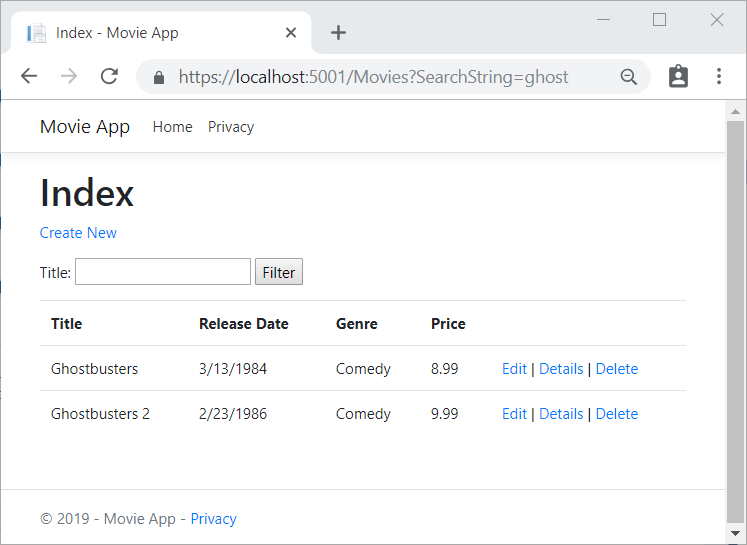
以下标记显示对 form 标记的更改:
HTML
<form asp-controller="Movies" asp-action="Index" method="get">
添加按流派搜索
将以下 MovieGenreViewModel 类添加到“模型”文件夹:
C#
using Microsoft.AspNetCore.Mvc.Rendering;
using System.Collections.Generic;
namespace MvcMovie.Models
{
public class MovieGenreViewModel
{
public List<Movie> Movies;
public SelectList Genres;
public string MovieGenre { get; set; }
public string SearchString { get; set; }
}
}
“电影流派”视图模型将包含:
- 电影列表。
- 包含流派列表的 SelectList。 这使用户能够从列表中选择一种流派。
- 包含所选流派的 MovieGenre。
- SearchString包含用户在搜索文本框中输入的文本。
将 MoviesController.cs 中的 Index 方法替换为以下代码:
C#
// GET: Movies
public async Task<IActionResult> Index(string movieGenre, string searchString)
{
// Use LINQ to get list of genres.
IQueryable<string> genreQuery = from m in _context.Movie
orderby m.Genre
select m.Genre;
var movies = from m in _context.Movie
select m;
if (!string.IsNullOrEmpty(searchString))
{
movies = movies.Where(s => s.Title.Contains(searchString));
}
if (!string.IsNullOrEmpty(movieGenre))
{
movies = movies.Where(x => x.Genre == movieGenre);
}
var movieGenreVM = new MovieGenreViewModel
{
Genres = new SelectList(await genreQuery.Distinct().ToListAsync()),
Movies = await movies.ToListAsync()
};
return View(movieGenreVM);
}
以下代码是一种 LINQ 查询,可从数据库中检索所有流派。
C#
// Use LINQ to get list of genres.
IQueryable<string> genreQuery = from m in _context.Movie
orderby m.Genre
select m.Genre;
通过投影不同的流派创建 SelectList(我们不希望选择列表中的流派重复)。
当用户搜索某个项目时,搜索值会保留在搜索框中。
向“索引”视图添加“按流派搜索”
按如下更新 Index.cshtml:
HTML
@model MvcMovie.Models.MovieGenreViewModel
@{
ViewData["Title"] = "Index";
}
<h1>Index</h1>
<p>
<a asp-action="Create">Create New</a>
</p>
<form asp-controller="Movies" asp-action="Index" method="get">
<p>
<select asp-for="MovieGenre" asp-items="Model.Genres">
<option value="">All</option>
</select>
Title: <input type="text" asp-for="SearchString" />
<input type="submit" value="Filter" />
</p>
</form>
<table class="table">
<thead>
<tr>
<th>
@Html.DisplayNameFor(model => model.Movies[0].Title)
</th>
<th>
@Html.DisplayNameFor(model => model.Movies[0].ReleaseDate)
</th>
<th>
@Html.DisplayNameFor(model => model.Movies[0].Genre)
</th>
<th>
@Html.DisplayNameFor(model => model.Movies[0].Price)
</th>
<th></th>
</tr>
</thead>
<tbody>
@foreach (var item in Model.Movies)
{
<tr>
<td>
@Html.DisplayFor(modelItem => item.Title)
</td>
<td>
@Html.DisplayFor(modelItem => item.ReleaseDate)
</td>
<td>
@Html.DisplayFor(modelItem => item.Genre)
</td>
<td>
@Html.DisplayFor(modelItem => item.Price)
</td>
<td>
<a asp-action="Edit" asp-route-id="@item.Id">Edit</a> |
<a asp-action="Details" asp-route-id="@item.Id">Details</a> |
<a asp-action="Delete" asp-route-id="@item.Id">Delete</a>
</td>
</tr>
}
</tbody>
</table>
检查以下 HTML 帮助程序中使用的 Lambda 表达式:
@Html.DisplayNameFor(model => model.Movies[0].Title)
在上述代码中,DisplayNameFor HTML 帮助程序检查 Lambda 表达式中引用的 Title 属性来确定显示名称。 由于只检查但未计算 Lambda 表达式,因此当 model、model.Movies[0] 或 model.Movies为 null 或空时,你不会收到访问冲突。 对 Lambda 表达式求值时(例如,@Html.DisplayFor(modelItem => item.Title)),将求得该模型的属性值。
通过按流派搜索、按电影标题搜索以及按流派和电影标题搜索来测试应用:
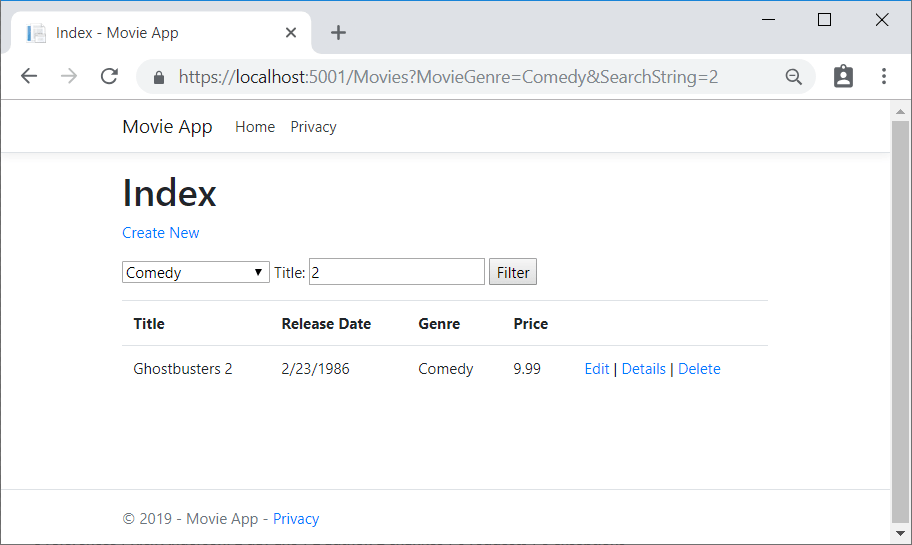





更多建议: